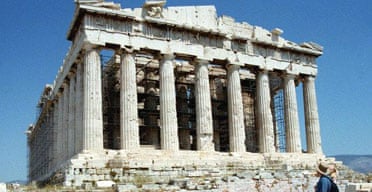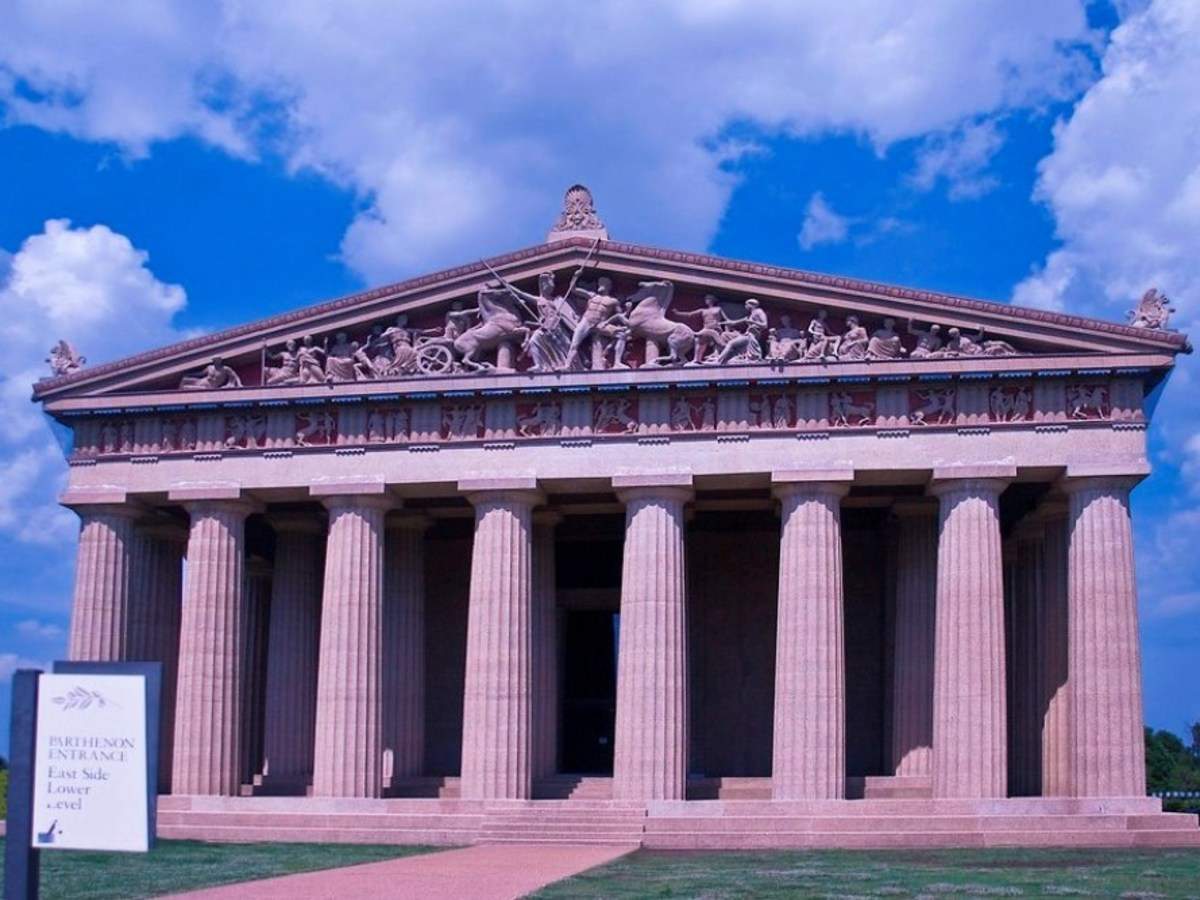Parthenon in Athens: A Journey into Ancient Greek Architecture

Welcome to your journey into ancient Greek architecture, where we will explore the magnificent Parthenon in Athens. Prepare to be amazed by this architectural wonder's intricate design and historical significance.
Overview of the Parthenon and its significance in Ancient Greek architecture
The Parthenon is a temple located on the Acropolis of Athens and is one of the most iconic examples of ancient Greek architecture. Built in the 5th century BCE, it was dedicated to the goddess Athena, the patron deity of Athens. The temple is renowned for its harmonious proportions, stunning marble sculptures, and innovative architectural features.
This masterpiece of architecture symbolizes the peak of classical Greek art and culture. Its design reflects the principles of classical order, with its columns, entablature, and pediment carefully proportioned to create a sense of balance and harmony. The refined aesthetic of the Parthenon influenced countless buildings throughout history.
Historical background of the construction and purpose of the Parthenon
The construction of the Parthenon began in 447 BCE under the guidance of the renowned architect Phidias. It took approximately nine years to complete. The temple was designed to replace an older temple destroyed during the Persian Wars, signalling Athens' victory and the city's emergence as a dominant cultural and political power.
The primary purpose of the Parthenon was to house the colossal statue of Athena Parthenos, created by Phidias himself. This statue was made of gold and ivory, depicting Athena armed and wearing a helmet. The statue stood approximately 38 feet tall, making it one of ancient Greece's most impressive works of art.
Apart from its religious significance, the Parthenon also served as a symbol of Athenian democracy and power. The sculptural friezes and metopes depicted various mythological and historical scenes, highlighting Athens' cultural and military achievements.
Despite the ravages of time, wars, and natural disasters, the Parthenon still stands as a testament to the ingenuity and artistic prowess of the ancient Greeks. Its harmonious design and exquisite craftsmanship have inspired architects and artists for centuries, leaving an indelible mark on architecture.
So, take a journey back in time and immerse yourself in the grandeur of the Parthenon. Experience the beauty of its architecture and appreciate the legacy it has left behind.

Architectural Design and Features
Architectural elements of the Parthenon
Stepping into the world of ancient Greek architecture, you'll find the Parthenon in Athens to be an exemplary masterpiece. Built to honour the goddess Athena, this magnificent temple showcases remarkable architectural elements that have stood the test of time.
One of the key features of the Parthenon is its impressive colonnade, consisting of eight columns at the front and back and seventeen columns on each side. These columns, with their distinctive fluted shafts and decorative capitals, exemplify the Doric style of architecture. The Doric order is known for its simple yet imposing design, emphasizing strength and stability. Additionally, the columns have a slight curvature called entasis, which creates an optical illusion of perfectly straight lines to the human eye.
The Parthenon's stunning pediments, or triangular gable ends, display intricate sculptural works. The east pediment depicts the birth of Athena from the head of Zeus, while the west pediment portrays the contest between Athena and Poseidon for the city of Athens. These sculptural compositions showcase the Greek's mastery of creating lifelike figures and capturing complex narratives in stone.
Intricate details and sculptures found on the Parthenon's friezes
The Parthenon's friezes are another noteworthy aspect of its architectural splendour. These continuous bands of sculptural reliefs wrap around the temple's exterior, depicting various mythological and historical scenes. One of the most renowned friezes, the Panathenaic procession, portrays the grand procession held every four years to honour Athena during the Panathenaic Festival.
The level of detail and artistic skill displayed in these friezes is awe-inspiring. The sculptors meticulously carved the figures to create a sense of movement and depth. The friezes depict mythical stories and showcase scenes from daily life, such as musicians, dancers, and horseback riders. These intricate details provide valuable insights into ancient Greek society and culture.
It's important to note that many of the original sculptures and architectural pieces of the Parthenon have been lost or damaged over time. Today, these magnificent works can be seen in museums, such as the British Museum in London and the Acropolis Museum in Athens, which houses a collection of the surviving marble masterpieces.
The Parthenon's architectural design, ancient craftsmanship, and rich historical significance make it a must-visit destination for anyone interested in ancient Greek culture. Walking through its grand columns and admiring the intricate details on its friezes is like stepping back in time, immersing yourself in the beauty and ingenuity of the ancient world. It's a journey that will leave you in awe of the indelible mark of ancient Greek architecture on human history.

Restoration and Preservation Efforts
Challenges faced in preserving the Parthenon
When it comes to preserving the Parthenon, there have been numerous challenges due to its age, weathering, and historical significance. The most significant challenge is the continuous deterioration caused by natural elements such as rain, wind, and pollution. These factors have led to the erosion of the marble, loss of sculptures, and structural instability over time.
Another challenge has been the impact of human activities on the monument. Despite efforts to restrict access and implement conservation measures, the sheer number of visitors, vandalism, and pollution from nearby industries and traffic have taken a toll on the Parthenon.
Modern restoration endeavours and controversies surrounding them
Over the years, various restoration projects have been undertaken to preserve and restore the Parthenon to its former glory. These projects involve meticulous research, analysis, and advanced technology to ensure accuracy and authenticity.
One such endeavour is the ongoing Acropolis Restoration Project, which began in the 1970s and aims to address the structural issues and conservation challenges faced by the Parthenon. The project involves carefully dismantling, cleaning, and reassembling the temple, using original and replica materials where necessary.
However, these restoration efforts have not been without controversy. One of the major debates surrounding the restoration is whether to return the missing fragments and sculptures, known as the Elgin Marbles, to their original location in Athens. These marbles are currently housed in the British Museum in London, and the Greek government has been advocating for their repatriation.
Another contentious issue is the use of replicas in the restoration process. While replicas help recreate the original appearance of the Parthenon, some argue that they diminish the authenticity and historical value of the monument.
Despite the controversies, the restoration efforts continue, driven by the commitment to preserve one of the world's most iconic architectural achievements. These endeavours contribute to the understanding and appreciation of ancient Greek culture but also ensure that future generations can experience the awe-inspiring beauty of the Parthenon.

Symbolism and Religious Significance
Religious and cultural significance of the Parthenon in Ancient Greece
When you visit the Parthenon in Athens, you are stepping into a world that dates back to ancient Greece. This magnificent structure holds immense religious and cultural significance in the history of Greek civilization. The Parthenon was dedicated to the goddess Athena, the patron deity of Athens, who was considered the city's protector. The temple served as a place of worship and a symbol of Athenian power and pride.
In ancient Greece, religion played a central role in everyday life. The construction of the Parthenon was a testament to the importance of the gods in the lives of the Athenians. The temple was built to honour Athena and to thank her for her guidance and protection. The grandeur of the structure was a reflection of the city's wealth and power, as well as its devotion to the gods.
Representation of Greek gods and goddesses in the Parthenon's design
As you explore the Parthenon, you will notice intricate carvings and sculptures depicting various Greek gods and goddesses. These representations serve as a visual representation of the gods and their significance in the lives of the ancient Greeks.
The most famous example is the statue of Athena Parthenos, a colossal statue of the goddess Athena that once stood inside the temple. This gold and ivory statue was considered one of the Seven Wonders of the Ancient World. Unfortunately, the original statue no longer exists, but its influence on the design of the Parthenon is evident.
Other sculptures and reliefs on the friezes of the Parthenon depict scenes from Greek mythology, including the birth of Athena, the battle between the gods and the Giants, and the Panathenaic procession. These intricate details not only showcase the skill and craftsmanship of ancient Greek artists but also provide insight into the religious beliefs and stories of the time.
The Parthenon's design and artistic elements make it a treasure trove of ancient Greek history and mythology. It is a place where you can immerse yourself in the rich cultural and religious heritage of the Greeks and gain a deeper understanding of the significance of the gods and goddesses in their lives.
The Parthenon truly is a journey into ancient Greek architecture, where you can marvel at its construction's mastery, appreciate its symbolism, and experience the religious and cultural significance of ancient Greece.

Visiting the Parthenon
Tips and guidelines for visiting the Parthenon in Athens
Are you planning a trip to Athens? Then a visit to the Parthenon is an absolute must! As you embark on this journey into ancient Greek architecture, here are some tips and guidelines to make your experience more memorable and enjoyable.
-
Plan your visit: The Parthenon is a popular attraction, so it's best to plan it. Check the opening hours and consider visiting during weekdays to avoid large crowds.
-
Wear comfortable shoes: Exploring the Parthenon involves walking uphill and on uneven paths. Wear comfortable shoes to make your visit more comfortable and enjoyable.
-
Bring water and snacks: There are no food or drink vendors on the Acropolis, so it's a good idea to bring your water and snacks to stay hydrated and energized during your visit.
-
Respect the site: The Parthenon is a significant historical site, so be respectful of its importance and follow any rules and guidelines set in place. Do not touch or climb on the ruins; be mindful of other visitors.
-
Take your time: The Parthenon is a masterpiece of ancient architecture, so take your time to observe and appreciate its beauty. Walk around the site, explore the surrounding areas, and soak in the history and grandeur of this iconic monument.
Notable attractions and points of interest near the Parthenon
While the Parthenon may be the star attraction on the Acropolis, other notable points of interest in the area are worth exploring. Here are a few:
-
Erechtheion: Located adjacent to the Parthenon, the Erechtheion is a stunning temple known for its six female statues called the Caryatids. Marvel at the intricate designs and learn about the mythological stories associated with this ancient temple.
-
Acropolis Museum: Before or after visiting the Parthenon, explore the Acropolis Museum. It houses a remarkable collection of artefacts and artworks from ancient Greece, providing further insight into the history and culture of the region.
-
Theatre of Dionysus: Situated on the southern slope of the Acropolis, the Theater of Dionysus is one of the oldest theatres in the world. Step back in time and imagine the ancient plays and performances that once took place in this enchanting setting.
-
Odeon of Herodes Atticus: This ancient amphitheatre, built in the Roman era, hosts performances today. If you can, attend a concert or theatre performance in this magnificent setting for a truly unforgettable experience.
As you explore the Parthenon and its surroundings, take the time to savour the atmosphere and immerse yourself in ancient Greece's rich history and cultural heritage. It's an experience that will leave you in awe of this ancient civilisation's architectural brilliance and legacy.
